Hand signals for dogs can be a valuable part of your dog’s training, no matter whether your dog is deaf or not. In fact, integrative veterinarian Dr. Julie Buzby encourages all dog parents to pair the hand signal and the verbal cue together when training your dog. She explains why this is the case and teaches you 13 common hand signals for dogs that can come in handy (no pun intended).
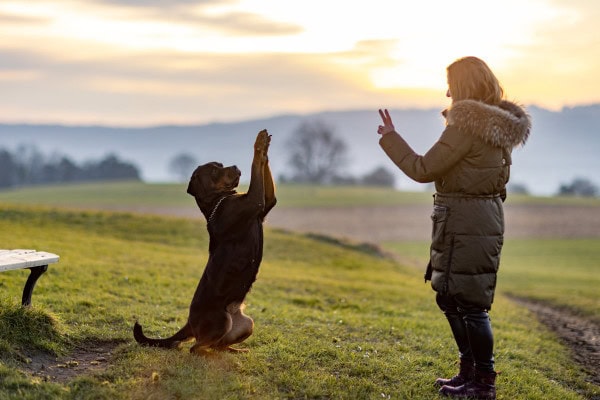
When you consider how to communicate with your dog, you may think of verbal cues (e.g. sit, down, walk, etc.). After all, words are the primary way we communicate with other people. Most of the time, verbal cues work for dogs too because dogs learn the meaning of certain words and phrases over time.
But what if you adopt a dog who is deaf? Or what if your dog becomes deaf in his or her senior years? I often have clients ask me if it’s possible to communicate with and train deaf dogs.
My answer is always, “Yes!” Training a deaf dog is possible. Among other things, you can teach your dog hand signals in order to communicate with him or her.
But hand signals aren’t just for deaf dogs. I believe that using hand signals for dogs is helpful for both hearing dogs and deaf dogs. Let’s take a look at why this is the case and learn 13 dog hand signals I have used with my own dogs and patients.
Why use dog training hand signals?
Hand signals have a broad application for many dogs.
Understandably, dogs who are deaf or hard of hearing can benefit the most from hand signals. Since a dog who is deaf can’t hear verbal commands, body language and hand motions are the most effective ways to communicate with your deaf dog. This applies to dogs who are born deaf and those who develop hearing loss in dogs later in life.
But I also encourage owners with younger, hearing dogs to incorporate hand signals in their dog’s training. Personally, I teach all my dogs (even my puppies) hand signals as a part of their training. And even though my dogs aren’t deaf, I use hand signals routinely when I communicate with my dogs.
Here’s why I think all dogs can benefit from dog training hand signals.
Hand signals allow you to communicate with your dog from a distance
Hand signals are useful even for hearing dogs. When I am with my dogs on a hike or working around my yard, it is sometimes nice to be able to use hand motions to communicate with them. With hand signals, my dogs can understand what I need from them without me having to yell loudly. A simple visual cue is less disruptive and easier to get across.
Or, if I am in a noisy situation where there is a lot of commotion around me, I may use visual cues. My dogs know that it is me communicating with them. They can see me and watch what I am signing. Otherwise, they would have to be listening for my voice to distinguish whether it is me or someone else talking.
Hand signals are helpful if your dog becomes deaf later in life
Puppies and young dogs eventually become senior dogs. Even though we don’t like to think about our new puppy or young dog growing older, it will happen. And unfortunately, we can’t predict exactly what our dogs’ senior years will look like.
We don’t want to have to think about our dog developing hearing loss any more than other senior dog problems like osteoarthritis in dogs, signs of dementia in dogs, or cancer. But teaching deaf dog hand signals while your dog is young can make communication easier if your dog becomes deaf. Being able to still tell your dog what you want makes the adjustment to hearing loss a bit easier for your dog, and for you too.
Dogs may prefer hand signals or understand them better
Perhaps because they naturally communicate primarily through body language, dogs may respond better to hand signals than verbal cues. This theory was supported by a study in Animal Cognition on the importance of gestures for dog human communication. In the study, researchers tested verbal and hand signals in 25 water search and rescue dogs who were trained in both types of signals.
With verbal commands alone, the dogs were 82% accurate when responding. But accuracy increased to 99% with hand signals alone. And when given incongruous hand signals and verbal cues (e.g. verbal cue to sit and hand signal to lie down), the dogs performed the action requested by the hand signal 70% of the time.
While this is a small study, the data lends credence to the idea that hand signals can be a great way to communicate with all dogs, not just deaf dogs.
Learning hand signals is mentally simulating for your dog
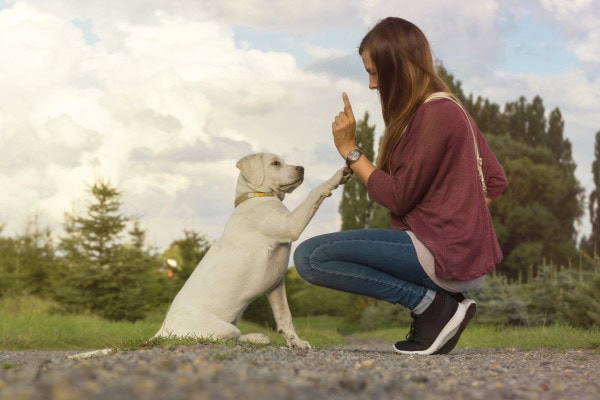
Finally, hand signals can be a new and fun trick for your dog to learn—whether he or she is deaf or not. It’s another way to provide mental stimulation to your dog that is enjoyable and useful.
When should I teach my dog hand signals?
For all these reasons, I recommend teaching your dog hand signals from the start if possible. While a dog does not have to be able to hear to learn hand signals, it is sometimes easier for dog parents to teach them to a hearing dog.
Teaching hand signals along with verbal cues makes sense
Most dog parents plan to train their puppies or newly adopted dogs in basic obedience. Verbal commands like “sit,” “stay,” and “come” are already at the front of their mind. So, it just makes sense to teach your dog the hand signals for those commands at the same time. You can easily pair the word “sit” with the hand signal for “sit,” and so forth.
In fact, many of my clients have told me that it feels natural to incorporate hand signals into verbal training. For example, a lot of dog parents unintentionally put a hand up in front of them when teaching a dog to “stay.” They may not be purposefully trying to teach their dog that this motion means “stay” like the word does. But they still subconsciously use the hand motion.
However, don’t despair if you didn’t teach your dog verbal cues and hand signals at the same time. Your dog can learn to respond to visual signals at most any age.
How do you teach your dog hand signals?
Whether you are interested in teaching your new dog hand signals or trying to communicate with your senior or deaf dog, let’s discuss how to train a dog with hand signals.
Anytime you are teaching your dog a new trick, it is important to keep the experience positive and encouraging. You should always use positive reinforcement when working with your dog. This means giving your dog a reward (such as praise, loving pets, or a treat) for performing the requested behavior.
It’s important to note that you should never punish a dog if he or she does not perform the command. Simply remove the praise and try again. Keeping a training session fun and positive will help dogs learn faster!
Dog training hand signals chart
When training your dog, there is a long list of potential dog commands and hand signals. I have met deaf dogs who know up to 20 different hand signals!
Below is a chart of some hand signals that you may want to use with your deaf dog.
| Command | Hand signal |
|---|---|
| Make eye contact | Take two fingers and hold them up to make a “V.” Then point the fingers toward your eyes. |
| Come | 1. Bring your hand to about chest level and curl your fingers up and toward your chest multiple times to simulate the “come here” motion. OR 2. Hold your open hand by your side and bring it across your body to your opposite shoulder so your arm crosses your chest. |
| Sit | Hold your hand in front of you with the palm facing up then bend your elbow to bring the arm up toward your body so it is at a 90-degree angle. |
| Lie down | 1. Hold your finger horizontally at chest level and move your hand down your chest. OR 2. Move an open hand (palm down) toward the ground. |
| Stand | Hold an open hand in front of your dog’s nose then pull it toward you. |
| Stay | Hold your hand up in front of you with the palm open and facing away from you. |
| Drop it | Start with a closed fist held in front of you and pointing downward. Then open the fist quickly like you are dropping something. |
| Leave it | Start with both hands in front of you with palms facing inward. Then move your hands up and down quickly. |
| Yes | Make a horizontal fist then move it up and down as if nodding with your hand. |
| No | Wag one finger up and down or hold one finger up and flick it downward once. |
| Quiet | Put one finger to your lips. |
| Walk or go outside | Move your fists in a circular motion around each other. |
| Heel | Place your hand by your hip and either tap your hip or make a circular motion near your hip with a fist. |
| All done or free | Use the palm of one hand to brush over the palm of your other hand from wrist to fingertips. |
While these are my favorites, you can change them or use whatever hand signals you would like with your dog. The most important thing is that the action is consistent, clear, and easy to understand for both you and your dog.
13 Hand signals for dogs
Now let’s take a closer look at some of the basic hand signals that work best for my dogs and patients. In my instructions, I am going to specifically talk about training deaf dogs. But you can use the same methods for hearing dogs as well. In that case, I recommend pairing the methods below with your normal voice commands.
Getting your dog’s attention
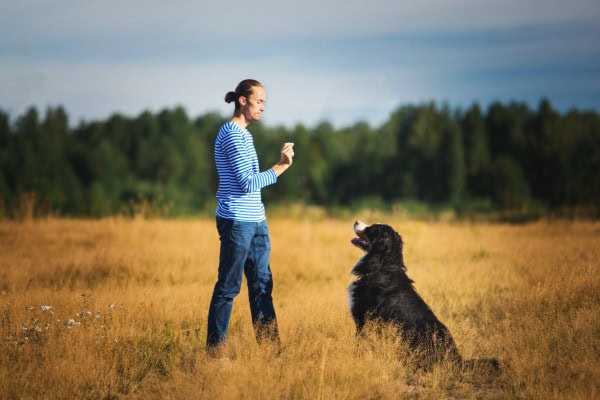
Before we talk about specific commands, you need to understand how to capture the attention of your dog. Otherwise your dog won’t know to look at you so he or she can see and respond to the cues.
There are many different methods to get your dog’s attention. For dogs who have normal hearing or are not completely deaf, some dog parents like to use a whistle or clapping.
If your dog is completely deaf, many of my clients like to use dramatic hand waving. This signals their dog to look at them and be prepared for the next signal. Other dog parents might use a gentle vibration from a collar (not a shock or water squirting collar). These tools are most commonly used when dogs are not right next to their owner (such as on a hike or at the dog park).
A note about flashlights: While you may see some resources recommending using a flashlight to get your dog’s attention, I don’t personally like this method. Some deaf dogs have become compulsive light chasers after being rewarded for paying attention when they see a flash of light. Plus, since there are plenty of uncontrollable flashes of light (e.g. reflections or people turning on lights), this method can be confusing for your dog.
1. Hand signal for “make eye contact”
In addition to capturing your dog’s attention, it is also important to train your deaf dog to make frequent eye contact. Eye contact is important for training any dog (deaf or hearing). And it is often the first command I tell dog parents to teach their dogs.
Learning to make eye contact early on in training will help your dog understand that he or she should be looking to you for guidance and direction. Also, dogs detect body language easily. So they can respond to commands better by looking at your face and acknowledging your body language.
For deaf dogs, I have a hand signal for eye contact. My favorite one is to take two fingers and hold them up to make a “V” or the number “2.” Then raise your hand to your face and point the fingers toward your eyes.
During training, each time your dog looks at your eyes when you do this motion, reward him or her. Through repetition and positive reinforcement, your dog will learn that this motion means to make eye contact with you.
Note: This is meant to be a soft or gentle eye contact. If you are staring hard at your dog, he or she may perceive the eye contact as a threat and react aggressively or get nervous.
2. “Come” hand signal for dogs
To teach your dog the “come” hand signal, raise your hand to about chest level with your palm facing toward you. Then, curl your fingers up and toward your chest multiple times to simulate the “come here” motion. Think about a mom motioning her toddler to “come here” with her hand. This is the same motion you are trying to achieve.
Alternatively, you can teach “come” by holding your hand at your side. Your hand should be open and face outward (away from you). Now, bring it across your body to your opposite shoulder so your arm crosses your chest. You may repeat this motion twice.
Remember to reward your dog for coming to you!
3. Hand signals for “sit”
Another one of the most common commands that deaf dogs learn is a hand signal for “sit.” To use this hand signal, hold your hand in front of you with your palm facing up. Bend your arm at your elbow and bring your arm and hand up toward you so that your arm is now bent in a 90-degree angle and your open palm is toward your face.
4. Dog hand signal for “lie down”
There are two common hand signals for the “lie down” command. Choose the one that works for you and your dog.
The first is to take one finger and hold it horizontally at your chest. Then, move your hand down your chest and upper body, being sure to keep your finger pointing to the side.
The other motion is to use one open hand with your palm facing down toward the ground. Hold your hand in front of you and then move it downward as if you are pushing something to the ground.
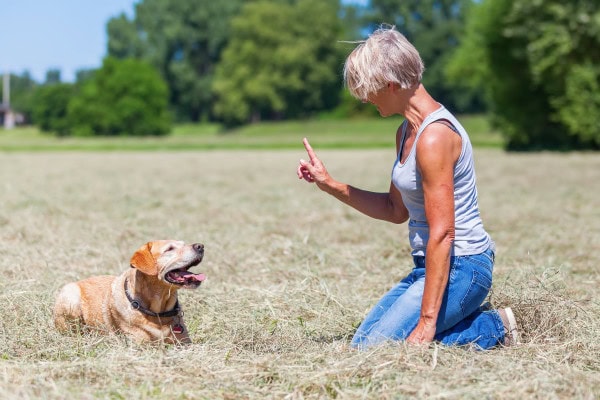
5. “Stand” hand signal for dogs
Once your dog knows how to lie down, you might want to also teach him or her how to “stand up” on command.
“Stand” can be taught by holding a hand open in front of the dog’s nose. Then move your hand away from your dog’s nose in a straight line. It is almost like your hand is a string pulling the dog forward into a standing position.
When you are teaching your deaf dog how to respond to the hand signal for “stand,” you might need to leave the leash on your dog. Start by having your dog in a sitting or lying down position. Then, simultaneously move your hand in the motion described while gently applying pressure to the leash to encourage your dog to stand up. Be sure that the hand signal is obvious. And encourage your dog to stay standing for 5 to 10 seconds to help cement the action.
Reward your dog for standing and repeat multiple times. Eventually, you will be able to decrease or remove the leash because your dog will know that the hand signal means “stand up.”
6. Dog hand signal for “stay”
To teach “stay,” start with your dog in a “sit” or “lie down” position. Then, hold your hand up in front of you with your palm open and facing away from you.
Start out with short distances when teaching “stay.” Continue to hold your hand up in front of you as you slowly back away, then reward your dog for “staying.” Gradually lengthen the distance between you and your dog as you practice more.
Many people use this same signal for “wait” (like when a dog should wait to start eating their food). But, other pet parents like to create a separate dog hand signal for wait.
7. Dog hand signal for “drop it”
To teach “drop it,” hold a hand in front of you as a closed fist pointing downward. Then, flick the fingers out to open the fist.
To remember this cue, imagine that you are holding a small ball in your fist and then releasing it to bounce on the floor.
8. Dog hand signal for “leave it”
Knowing how to tell your deaf dog to leave an item alone is just as important as being able to tell him or her release or drop an item. So, training your dog to know a hand signal for “leave it” is very useful.
The cue for “leave it” is to take both hands and hold them in front of you with palms facing inward. Then move your hands in a quick up-and-down motion while keeping them both open and palms facing inward.
Teaching “leave it”
This can be one of the more difficult hand signals to teach a dog. To teach your dog this cue, it is important to train him or her to ignore a tempting item and look at you for direction. The best way to do this is by taking a treat (or a toy) and setting it on the ground. Immediately cover the treat with your hand. Then wait for your dog to look at you rather than trying to get the treat or toy.
When your dog looks at you, say or motion “yes” (see #9). Then give your dog a different, higher-level reward treat with the opposite hand that was not covering the treat. Repeat this multiple times until your dog learns to quickly look at you when the first treat is on the ground instead of trying to eat it.
Once your dog has mastered this part, you can practice dropping the treat instead. Take a treat or toy and drop it at your feet. Quickly cover it with your foot. When your dog stops looking at the treat under your foot, make the hand signal for “leave it” and give your dog the higher-level reward treat.
Again, repetition is key. Eventually, your dog will learn to look at you each time something falls near you to know if it’s okay to eat the item or if it should be left alone.
9. Hand signal for “yes” and “no”
While “leave it” is very helpful for a dog to know, some dog parents prefer to stick with simple “yes” and “no” cues. And other dogs know “leave it,” “yes,” and “no.”
“Yes” is a very easy signal to teach most dogs because you can pair it with a treat anytime your dog does a behavior you want to reward. To teach “yes,” simply hold your hand in front of you and make a horizontal fist. Then, move your fist up and down as if it is nodding.
There are many different hand signals for “no.” Some people prefer to use the traditional one-finger wagging method. This involves taking a single finger and holding it up and wagging it back and forth (just like a mom telling a little kid “no”).
Other dog parents like to take a single finger and hold it up and then flick it downward to say “no.” You can use whatever hand signal feels best for you and your dog.
10. “Quiet” hand signal for dogs
Another hand signal that can come in handy is “quiet.” Deaf dogs sometimes bark when there is no reason to because they can’t hear how much noise they are making. We see this very commonly in deaf dogs who also have canine cognitive dysfunction.
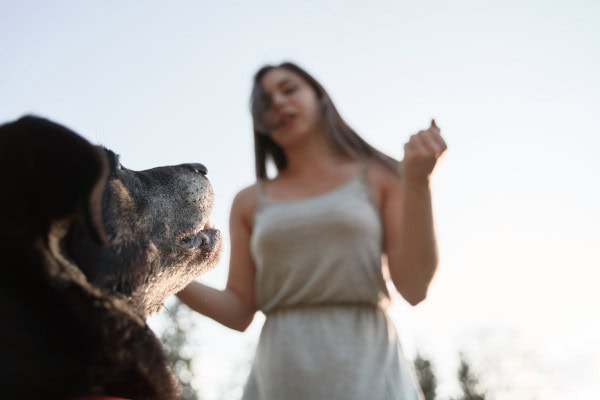
This signal is easy to remember. Simply place one finger to your lips as if you are telling someone to whisper or be quiet.
11. Signal for “walk” or “go outside”
I also encourage dog parents to teach their dog a hand signal for “walk” or “go outside.” It is helpful to be able to ask if your dog needs to go outside to urinate or to enjoy the fresh air.
To signal “walk,” hold both hands as fists in front of you. Then, move them in a circular motion around each other. This can signal to your dog that he or she needs to go outside or that it is time to go on a nice evening stroll together.
12. “Heel” hand signal
Heel is a signal that is fairly easy to teach by using a leash to reinforce the desired behavior.
The hand cue for “heel” is to put your hand near your hip. You can either tap your hip with your hand or make a circular motion with your fist near your hip. I personally prefer to tap my hip so the signal is a little more distinct from the signal for “walk.”
13. Hand signal for “all done” or “free”
Finally, while it is important for dogs to know to look at their owners and focus on them for commands, it is also necessary to let dogs know when they are done working and can go play or relax on their own. So I encourage all deaf dog owners to teach their dog a hand signal for “all done” or “free.”
To tell your dog that he or she is “free,” hold both hands in front of you. One hand should be open with the palm facing upward. The other hand should be above it and open with the palm facing downward. Take the hand with the palm facing down and swipe it over the other hand from back to front. Imagine that you are wiping a piece of dirt off your palm and fingertips.
Other hand signals
Additionally, there are so many more commands that your dog is capable of learning. Some of the other dog hand signals that I have seen dog parents use include:
- “Back up”
- “Get your toy”
- “Food”
- “Go to the door”
- “Roll over”
- “High five”
Which signals your dog learns should be tailored to your dog’s needs and your lifestyle. It might be a bit different for each dog, and that’s ok.
Get started teaching your dog hand signals
If you are looking for a way to communicate with your deaf dog, help your dog know what to do from a distance, or give your dog some mental stimulation, hand signals can be a great option. They are convenient, require no extra equipment, and are easy to learn.
Maybe you are training your newly adopted dog or puppy. In that case, now is the perfect time to incorporate hand signals. But even if your dog has been trained for awhile, it is never too late to start teaching him or her some hand signals. Learning new hand signals can be fun. And it is a great way for you and your dog to bond and spend time together. Plus, hand signals can be useful in a variety of situations.
Which hand signals does your dog know?
Please comment below.


This is good, Our senior dog Hunter turns 13 in January and has lost most of his hearing this year 2024.
**We have a rule in our house when we are at the table. No dog noses at the table. They must lay down, no noses. For that we just have to stare at our dog and not move our eyes. He knows.
**For no more – we hold up both hands in front of us. The fingers spread a bit, like you’re shocked.
Hi Lynn,
Thank you for sharing! I think it really helps dogs when there are clear expectations, and they know the boundaries. You are doing a great job. Keep up the good work!